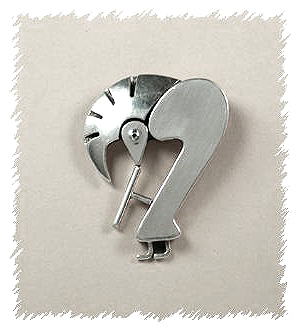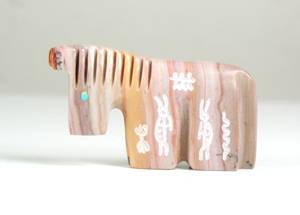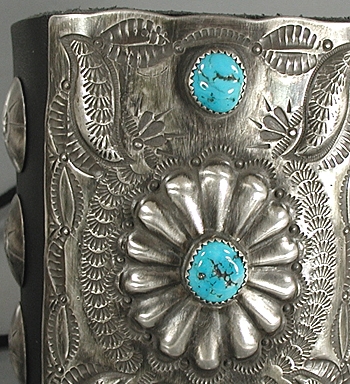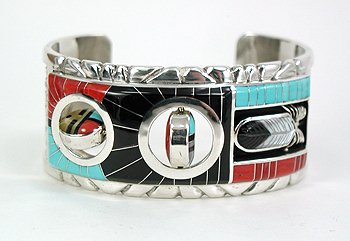A few years back a woman wrote me saying:
“I am looking for one of those turquoise indian rings.”
I thought, “Gee……..where do I start”……….?? So I asked her to describe the one she was looking for and she said “like a wedding band”. I immediately thought of the Zuni inlay rings that have been popular for many years and sold all over the southwest. I sent her this photo and she said – “Exactly”.

Phew, that was an easy one.
Shortly after that a man wrote asking for a ring like he saw in Thunderheart (the movie)
Now there I had a better idea of what he was looking for since I have watched that movie a dozen times and even got my husband a ring like the big turquoise oval one in the movie.

1 3/8″ turquoise ring by the late M. NARANJO, Tewa
However, there were at least 4 different types of rings in the movie, so I devoted a blog article to answer his question in detail – to see examples of the 4 rings in the movie, click the link below.
I want to get a ring like I saw in the movie Thunderheart
Over the years I have helped a number of people find the ring of their dreams. But I thought one way to further help would be to categorize, describe and show photos of some of the more commonly made types of Native American rings, thus creating a vocabulary of sorts to allow a dialogue to get started.
MATERIALS
In most cases, Native American rings are made from sterling silver – you can read about silver by clicking the link below to my blog post:
Jewelry Silver – Not All Silver is Created Equal
Some rings are solely made of sterling. But the vast majority also feature stones, shells and other materials.
Here is a list of commonly used materials in Native American rings: (I have written articles about some of the materials, so you can click on those that are hyperlinks to learn more). To read about other materials, look in the right hand column of the home page of this blog and you’ll see an outline of article topics – scroll to Materials – there are plenty more materials listed there.
Acoma Jet
Bear Claws and other claws
Coral
Gaspeite
Jasper
Lapis Lazuli
Mother of Pearl
Onyx
Opal (natural and imitation)
Malachite
Petrified Wood
Spiny Oyster (orange and purple)
Tiger Eye
Turquoise
White Buffalo Stone

TRIBAL STYLES
Generally southwest Native American rings are made by Navajo, Zuni or Hopi jewelers.
In VERY general terms, I’ll first describe the types of rings associated with each tribe but I’ll provide much more detail throughout this article.
Navajo rings are typically a sterling silver band, often heavy and/or elaborate. The band can be silver only or have stones that are set with various types of bezels. For more information on bezels, read my article Types of Bezels If a Navajo ring is inlaid, the inlay pieces are usually separated by silver channels.
Zuni rings are usually either stone-on-stone inlays (no silver channels in between the pieces), snake rings, snake eye, petit point or needlepoint.
Hopi rings are most often sterling silver overlays with contrasting (oxidized) and textured backgrounds.

NAVAJO RINGS
There are a number of ring styles that are associated with Navajo silversmiths. I’ll mention some of the most common and popular.
Storyteller
One traditional style of Navajo silver ring is a storyteller. Individual scenes depicting daily life are cut out of a sheet of silver and layed over an oxidized background.
Storyteller bracelets show Navajo life. The home (hogan) and the activities around the home such as cooking, weaving, tending livestock, driving a wagon to town. The scenery of the area such as buttes, trees and shrubs and sometimes clouds are also depicted.
This slideshow requires JavaScript.
Silver
There is nothing better for everyday wear than a well-made silver Navajo ring. Below is a slide show depicting some popular silver Navajo ring styles including stamped, repousse, overlay and more. Click here to see more silver rings.
This slideshow requires JavaScript.
Sandcast
Sand cast and tufa cast items are made using a mold into which molten silver is poured. Click to read more about Cast Jewelry, To see more cast rings, click here
This slideshow requires JavaScript.
Single Stone Turquoise
Possibly the most iconic Navajo ring is the single turquoise stone. Put one on and you feel like a million dollars. Below is a wonderful array of single stone turquoise rings, both polished cabochons and nuggets. To see more turquoise rings, click here.
This slideshow requires JavaScript.
Single Stone Other
When you need a Jet or Mother of Pearl or Lapis ring to go with your outfit, you will likely be able to find a beautiful Navajo single stone ring to fit the bill. To see more single stone rings, click here
This slideshow requires JavaScript.
Cluster
Cluster refers to a group of stones usually set in a circular or oval pattern. While often associated with Zuni artists, there are a number of Navajo smiths that have made cluster rings over the years. To see the cluster rings we have for sale, click here

Turquoise and Coral
A very popular color combination is coral and turquoise together. Turquoise is a happy stone by itself – add a dash of coral and you’ll just be giddy ! Very classic and classy. To see the turquoise and coral rings we have to offer, click here
This slideshow requires JavaScript.
MOP and Other Shell
Mother of Pearl, Pink Shell, Abalone, Paua Shell and other shells add a bit of gleam and glitter to a ring. To see more examples, click here.
This slideshow requires JavaScript.
Claw
Claw rings are a popular design, especially with men, The claws can be real or faux claws and traditionally are bear but can also be from smaller animals like coyotes. To see more examples of bear claw rings, click here.
This slideshow requires JavaScript.
Silver Channel Inlay
Navajo inlay usually features silver channels between pieces of stone. Click here to see more.
This slideshow requires JavaScript.
Inlay
Although pictorial inlay is more commonly associated with Zuni artists, there are a number of Navajo that make beautiful and unique inlay rings. Click here to see vintage Navajo rings.
This slideshow requires JavaScript.
Corn Row, Cobblestone and Mosaic Inlay
Three types of inlay that are somewhat similar are Mosaic Inlay (click the link to go to a separate article), Corn Row and Cobblestone inlay. They are a more 3 dimensional type of inlay than the flat inlay of Zuni artists.
This slideshow requires JavaScript.
Shadowbox
The shadowbox technique consists of a cutout top layer that is usually (but not always) domed and that is soldered to a solid bottom layer with or without a dark contrasting background. The shadowbox might be all silver or incorporate stones.
This slideshow requires JavaScript.
Leaf and Feather
A very popular design style for Navajo rings, especially those made for the tourist trade, is the incorporation of a leaf or feather along with the other silver work or stones. The leaves and feather might be hand made or the could be ready-made cast pieces that the silversmith purchases from a trading post and adds onto the ring. Some wrap around rings are made of a single feather. To see many examples of leaf and feather rings, click here.
This slideshow requires JavaScript.
Cigar Band
Cigar band style refers to a wide band with stamping. To read more about this style, click on my post- What is a Cigar Band Ring?
Here is an example of a cigar band ring using White Buffalo Stone. It was made by Tony Garcia.
This slideshow requires JavaScript.

ZUNI RINGS
Zuni rings are usually one of 4 types: Inlay, Petit Point, Needlepoint and Snake Eye.
Inlay
Zuni inlay is usually stone-on-stone inlay, that is, the stone or shell pieces touch each other, there is no silver channel work in between. However, just as I say that, you will see below some examples of Zuni inlay that does incorporate silver channels. There are no hard and fast rules – just generalizations.
This slideshow requires JavaScript.
Petit Point
Petit Point is comprised of long, narrow teardrop-shaped stones and possibly round dots.

Needlepoint
Needlepoint is comprised of straight, long, narrow stones that are pointed on both ends. Here are examples of needlepoint rings:
This slideshow requires JavaScript.
Snake Eye
Snake Eye rings are comprised of many tiny spherical cabochons of turquoise (usually). You can read more about Snake Eye in my article
Here is a 100 stone snake eye ring by April and Peter Halloo, Zuni
This slideshow requires JavaScript.
Here are more examples of snake eye rings:
This slideshow requires JavaScript.
Snake Rings
Some Zuni families, most notably that of Effie Calavaza, make snake motif rings.
This slideshow requires JavaScript.

HOPI RINGS
Hopi rings are traditionally overlay with contrasting (oxidized) and texturized backgrounds. Sometimes the designs are easily recognizable animal and other natural elements, other times they are abstracts.
Here is an example of a Hopi overlay ring by Raymond Kyasyousie.
This slideshow requires JavaScript.
More hopi ring examples:
This slideshow requires JavaScript.
To read more about rings, here is an interesting book that I reviewed here on this blog:
Paula


















































































